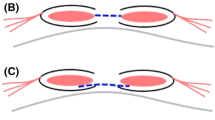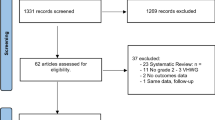Abstract
Background
Today, ventral hernia repair is predominantly performed with meshes. There is no meta-analysis of high quality evidence that compares the results of suture to mesh repair. The objective of this systematic review with meta-analysis is to compare patient centred outcomes of suture versus mesh repair.
Methods
A systematic literature search was performed in EMBASE, MEDLINE and CENTRAL (inception to 06/2014). Furthermore a hand search was performed. RCTs comparing suture versus mesh repair in primary and incisional ventral hernia repair were included. Data on patient characteristics, interventions and results were extracted in standardized tables. Risk of bias was assessed with the cochrane risk of bias tool. Results of studies were pooled with a meta-analysis. All steps were performed by two reviewers. Discrepancies were discussed until a consensus.
Results
The search in the databases resulted in 1560 hits. After screening, 10 randomized controlled trials including 1215 patients satisfied all inclusion criteria. Risk of bias was moderate to high. The relative risk for recurrence was 0.36 [95% CI (0.27, 0.49); I 2 = 0; heterogeneity p = 0.70]. Other complications did not differ significantly. Results for chronic pain were heterogeneous across studies.
Conclusion
Mesh repair reduces the number of recurrences significantly. In patients without recurrence mesh repairs seem to be associated with a risk of chronic pain especially if the mesh is fixed sublay.



Similar content being viewed by others
References
Sauerland S, Walgenbach M, Habermalz B et al (2011) Laparoscopic versus open surgical techniques for ventral or incisional hernia repair. Cochrane Database Syst Rev 16(3):CD007781
Itani KM, Hur K, Kim LT et al (2010) Comparison of laparoscopic and open repair with mesh for the treatment of ventral incisional hernia: a randomized trial. Arch Surg 145(4):322–328
Abdel-Baki NA, Bessa SS, Abdel-Razek AH (2007) Comparison of prosthetic mesh repair and tissue repair in the emergency management of incarcerated para-umbilical hernia: a prospective randomized study. Hernia 11(2):163–167
Venclauskas L, Maleckas A, Kiudelis M (2010) One-year follow-up after incisional hernia treatment: results of a prospective randomized study. Hernia 14:575
DeMaria EJ, Moss JM, Sugerman HJ (2000) Laparoscopic intraperitoneal polytetrafluoroethylene (PTFE) prosthetic patch repair of ventral hernia. Prospective comparison to open prefascial polypropylene mesh repair. Surg Endosc 14(4):326–329
LeBlanc KA, Booth WV (1993) Laparoscopic repair of incisional abdominal hernias using expanded polytetrafluoroethylene: preliminary findings. Surg Laparosc Endosc 3(1):39–41
Moher D, Liberati A, Tetzlaff J et al (2009) Preferred reporting items for systematic reviews and meta-analyses: The PRISMA statement. Ann Intern Med 151(4):264–269
Higgins JPT, Green S (eds) (2011). Cochrane handbook for systematic reviews of interventions Version 5.1.0. The cochrane collaboration. http://www.cochrane-handbook.org. Accessed Mar 2011
Higgins JP, Altman DG, Gotzsche PC et al (2011) The cochrane collaboration’s tool for assessing risk of bias in randomised trials. BMJ 343:d5928
Hartling L, Hamm MP, Milne A et al (2013) Testing the risk of bias tool showed low reliability between individual reviewers and across consensus assessments of reviewer pairs. J Clin Epidemiol 66(9):973–981
Hartling L, Ospina M, Liang Y et al (2009) Risk of bias versus quality assessment of randomised controlled trials: cross sectional study. BMJ 339:b4012
Ammar SA (2010) Management of complicated umbilical hernias in cirrhotic patients using permanent mesh: randomized clinical trial. Hernia 14(1):35–38
Arroyo A, Garcia P, Perez F et al (2001) Randomized clinical trial comparing suture and mesh repair of umbilical hernia in adults. Br J Surg 88(10):1321–1323
Burger JW, Luijendijk RW, Hop WC et al (2004) Long-term follow-up of a randomized controlled trial of suture versus mesh repair of incisional hernia. Ann Surg 240(4):578–583
Korenkov M, Sauerland S, Arndt M et al (2002) Randomized clinical trial of suture repair, polypropylene mesh or autodermal hernioplasty for incisional hernia. Br J Surg 89(1):50–56
Polat C, Dervisoglu A, Senyurek G et al (2005) Umbilical hernia repair with the prolene hernia system. Am J Surg 190(1):61–64
de Vries Reilingh TS, van Goor H, Charbon JA et al (2007) Repair of giant midline abdominal wall hernias: “components separation technique” versus prosthetic repair : interim analysis of a randomized controlled trial. World J Surg 31(4):756–763. doi:10.1007/s00268-006-0502-x
Luijendijk RW, Hop WC, van den Tol MP et al (2000) A comparison of suture repair with mesh repair for incisional hernia. N Engl J Med 343(6):392–398
Weber G, Baracs J, Horvath OP (2010) [“Onlay” mesh provides significantly better results than “sublay” reconstruction. Prospective randomized multicenter study of abdominal wall reconstruction with sutures only, or with surgical mesh–results of a five-years follow-up]. Magy Seb 63(5):302–311
Lal K, Laghari ZH, Laghari AA et al (2012) A comparative study of anatomical repair versus mesh repair in paraumbilical hernia. Med Channel 19(2):110–113
Nguyen MT, Berger RL, Hicks SC et al (2014) Comparison of outcomes of synthetic mesh vs suture repair of elective primary ventral herniorrhaphy: A systematic review and meta-analysis. JAMA Surg 149(5):415–421
den Hartog D, Dur AH, Tuinebreijer WE et al (2008) Open surgical procedures for incisional hernias. Cochrane Database Syst Rev 16(3):CD006438
Aslani N, Brown CJ (2010) Does mesh offer an advantage over tissue in the open repair of umbilical hernias? A systematic review and meta-analysis. Hernia 14(5):455–462
Timmermans L, de Goede B, van Dijk SM et al (2014) Meta-analysis of sublay versus onlay mesh repair in incisional hernia surgery. Am J Surg 207(6):980–988
Sajid MS, Parampalli U, McFall MR (2013) A meta-analysis comparing tacker mesh fixation with suture mesh fixation in laparoscopic incisional and ventral hernia repair. Hernia 17(2):159–166
Author contributions
Tim Mathes: Idea for the review, literature search, selection of literature, data extraction, risk of bias assessment, preparation of meta-analysis, writing of manuscript. Maren Walgenbach: Selection of literature, data extraction, risk of bias assessment, review of manuscript. Robert Siegel: Clinical expertise, interpretation of data, revision of manuscript.
Author information
Authors and Affiliations
Corresponding author
Ethics declarations
Conflict of interest
Nothing to declare.
Disclosure
None
Funding
There was no funding for this systematic review.
Electronic supplementary material
Below is the link to the electronic supplementary material.
Rights and permissions
About this article
Cite this article
Mathes, T., Walgenbach, M. & Siegel, R. Suture Versus Mesh Repair in Primary and Incisional Ventral Hernias: A Systematic Review and Meta-Analysis. World J Surg 40, 826–835 (2016). https://doi.org/10.1007/s00268-015-3311-2
Published:
Issue Date:
DOI: https://doi.org/10.1007/s00268-015-3311-2




